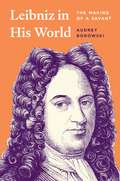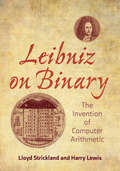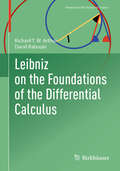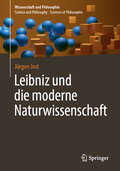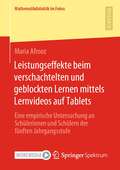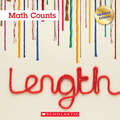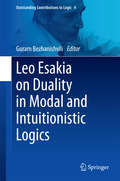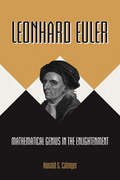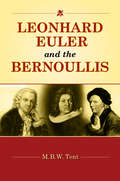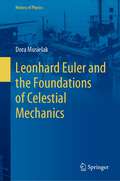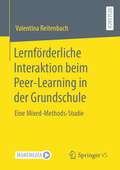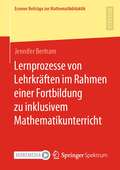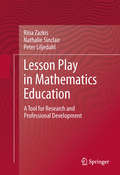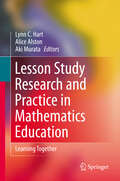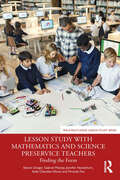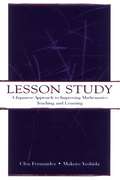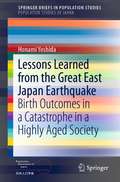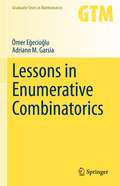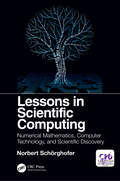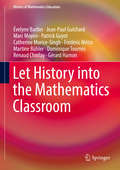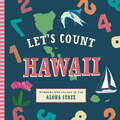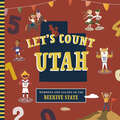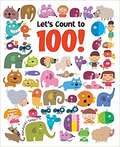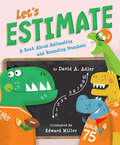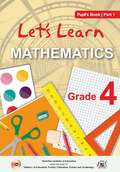- Table View
- List View
Leibniz in His World: The Making of a Savant
by Audrey BorowskiA sweeping intellectual biography that restores the Enlightenment polymath to the intellectual, scientific, and courtly worlds that shaped his early life and thoughtDescribed by Voltaire as &“perhaps a man of the most universal learning in Europe,&” Gottfried Wilhelm Leibniz (1646–1716) is often portrayed as a rationalist and philosopher who was wholly detached from the worldly concerns of his fellow men. Leibniz in His World provides a groundbreaking reassessment of Leibniz, telling the story of his trials and tribulations as an aspiring scientist and courtier navigating the learned and courtly circles of early modern Europe and the Republic of Letters.Drawing on extensive correspondence by Leibniz and many leading figures of the age, Audrey Borowski paints a nuanced portrait of Leibniz in the 1670s, during his &“Paris sojourn&” as a young diplomat and in Germany at the court of Duke Johann Friedrich of Hanover. She challenges the image of Leibniz as an isolated genius, revealing instead a man of multiple identities whose thought was shaped by a deep engagement with the social and intellectual milieus of his time. Borowski shows us Leibniz as he was known to his contemporaries, enabling us to rediscover him as an enigmatic young man who was complex and all too human.An exhilarating work of scholarship, Leibniz in His World demonstrates how this uncommon intellect, torn between his ideals and the necessity to work for absolutist states, struggled to make a name for himself during his formative years.
Leibniz on Binary: The Invention of Computer Arithmetic
by Lloyd Strickland Harry R. LewisThe first collection of Leibniz&’s key writings on the binary system, newly translated, with many previously unpublished in any language.The polymath Gottfried Wilhelm Leibniz (1646–1716) is known for his independent invention of the calculus in 1675. Another major—although less studied—mathematical contribution by Leibniz is his invention of binary arithmetic, the representational basis for today&’s digital computing. This book offers the first collection of Leibniz&’s most important writings on the binary system, all newly translated by the authors with many previously unpublished in any language. Taken together, these thirty-two texts tell the story of binary as Leibniz conceived it, from his first youthful writings on the subject to the mature development and publication of the binary system. As befits a scholarly edition, Strickland and Lewis have not only returned to Leibniz&’s original manuscripts in preparing their translations, but also provided full critical apparatus. In addition to extensive annotations, each text is accompanied by a detailed introductory &“headnote&” that explains the context and content. Additional mathematical commentaries offer readers deep dives into Leibniz&’s mathematical thinking. The texts are prefaced by a lengthy and detailed introductory essay, in which Strickland and Lewis trace Leibniz&’s development of binary, place it in its historical context, and chart its posthumous influence, most notably on shaping our own computer age.
Leibniz on the Foundations of the Differential Calculus (Frontiers in the History of Science)
by David Rabouin Richard T. ArthurThis monograph presents an interpretive essay on the foundations of Leibniz’s calculus, accompanied by key texts in English translation. The essay examines Leibniz's evolving views on infinitesimals and infinite numbers, tracing their development from his early metaphysical ideas to his mature justifications of the calculus. Leibniz first proposed treating infinitesimals as fictions in the 1670s, in line with the mathematical practices of his time, where abstract concepts could be used in calculations without implying their existence. By 1676, he rejected their status as quantities, yet continued to refine his arguments on this topic into the 1690s. The essay concludes with an analysis of Leibniz’s defense of his calculus in the early 18th century, showing how his later works naturally extended from earlier insights. This monograph will be a valuable resource for scholars and students of Leibniz and the history of science.
Leibniz und die moderne Naturwissenschaft (Wissenschaft und Philosophie – Science and Philosophy – Sciences et Philosophie)
by Jürgen JostWas hat ein Gelehrter des 17.Jahrhunderts noch für die heutigen Naturwissenschaften zu sagen? Eine ganze Menge, so zeigt sich in diesem Buch. Gottfried Wilhelm Leibniz (1646-1716) war ein Universalgenie, und ihm gelangen bahnbrechende Leistungen in fast allen Gebieten der Wissenschaft, insbesondere in der Philosophie (Relativität von Raum und Zeit), der Mathematik (Infinitesimalrechnung, Determinantentheorie, binäres Zahlsystem, Konstruktion einer Rechenmaschine), der Logik (Prädikaten- und Modallogik, Konzept der möglichen Welten), der Physik (Energieerhaltung und Aktionsprinzip), der Erd- und Menschheitsgeschichte, der Rechtswissenschaft und der Theologie. Diese Leistungen waren aber nicht isoliert, sondern eingebettet in ein umfassendes System, das auf dem Satz vom Widerspruch, dem Satz vom zureichenden Grunde und dem Kontinuitätsprinzip beruhte. Erst durch das Verständnis dieses Systems erschließen sich die Einheit und die Spannweite seines Denkens. Jürgen Jost, der wie nur wenige andere die verschiedenen Wissenschaften überblickt, konfrontiert dieses leibnizsche System mit den Ansätzen, Denkweisen und Ergebnissen der heutigen Naturwissenschaften, insbesondere der Quantenphysik, der Relativitätstheorie und Kosmologie, der modernen Logik, der Evolutionsbiologie und der Hirnforschung. Es zeigt sich, dass das leibnizsche System in vieler Hinsicht noch aktuell ist und sich bewährt, aber auch in manchen Positionen revidiert werden muss. Hieraus ergeben sich neue Einsichten sowohl in das leibnizsche System als auch in die heutigen Naturwissenschaften.
Leistungseffekte beim verschachtelten und geblockten Lernen mittels Lernvideos auf Tablets: Eine empirische Untersuchung an Schülerinnen und Schülern der fünften Jahrgangsstufe (Mathematikdidaktik im Fokus)
by Maria AfroozAuslöser der vorliegenden Forschungsstudie sind die Aktualität des Forschungsthemas sowie die mangelnden empirischen Untersuchungen im Mathematikunterricht und im Zusammenhang mit digitalen Medien: Das verschachtelte Lernen als ein neuer, kognitionspsychologischer Forschungsansatz in der Mathematikdidaktik erschwert kurzfristig das Lernen, führt jedoch langfristig zu besseren Leistungen der Lernenden. Die innovative Studie vereint den Ansatz des verschachtelten Lernens mit den selbst entwickelten Lernvideos, welche optimal im Mathematikunterricht integriert werden können.
Length (Math Counts: Updated Editions)
by Henry PluckroseAn introduction to capacity for the youngest readers!Math Counts series introduces young readers (grades K-3) to early math concepts. Real-world examples and corresponding photos make math concepts easy to grasp.We use the word length to describe the measurement of something from one end to the other.
Leo Esakia on Duality in Modal and Intuitionistic Logics
by Guram BezhanishviliThis volume is dedicated to Leo Esakia's contributions to the theory of modal and intuitionistic systems. Consisting of 10 chapters, written by leading experts, this volume discusses Esakia's original contributions and consequent developments that have helped to shape duality theory for modal and intuitionistic logics and to utilize it to obtain some major results in the area. Beginning with a chapter which explores Esakia duality for S4-algebras, the volume goes on to explore Esakia duality for Heyting algebras and its generalizations to weak Heyting algebras and implicative semilattices. The book also dives into the Blok-Esakia theorem and provides an outline of the intuitionistic modal logic KM which is closely related to the Gödel-Löb provability logic GL. One chapter scrutinizes Esakia's work interpreting modal diamond as the derivative of a topological space within the setting of point-free topology. The final chapter in the volume is dedicated to the derivational semantics of modal logic and other related issues.
Leonhard Euler
by Ronald S. CalingerThis is the first full-scale biography of Leonhard Euler (1707-83), one of the greatest mathematicians and theoretical physicists of all time. In this comprehensive and authoritative account, Ronald Calinger connects the story of Euler's eventful life to the astonishing achievements that place him in the company of Archimedes, Newton, and Gauss. Drawing chiefly on Euler's massive published works and correspondence, which fill more than eighty volumes so far, this biography sets Euler's work in its multilayered context--personal, intellectual, institutional, political, cultural, religious, and social. It is a story of nearly incessant accomplishment, from Euler's fundamental contributions to almost every area of pure and applied mathematics--especially calculus, number theory, notation, optics, and celestial, rational, and fluid mechanics--to his advancements in shipbuilding, telescopes, ballistics, cartography, chronology, and music theory.The narrative takes the reader from Euler's childhood and education in Basel through his first period in St. Petersburg, 1727-41, where he gained a European reputation by solving the Basel problem and systematically developing analytical mechanics. Invited to Berlin by Frederick II, Euler published his famous Introductio in analysin infinitorum, devised continuum mechanics, and proposed a pulse theory of light. Returning to St. Petersburg in 1766, he created the analytical calculus of variations, developed the most precise lunar theory of the time that supported Newton's dynamics, and published the best-selling Letters to a German Princess--all despite eye problems that ended in near-total blindness. In telling the remarkable story of Euler and how his achievements brought pan-European distinction to the Petersburg and Berlin academies of sciences, the book also demonstrates with new depth and detail the central role of mathematics in the Enlightenment.Some images inside the book are unavailable due to digital copyright restrictions.
Leonhard Euler and the Bernoullis: Mathematicians from Basel
by M. B. Tent"Leonhard Euler and the Bernoullis is a fascinating tale of the Bernoulli family and Euler's association with them. Successful merchants in the 16th and 17th centuries, the Bernoullis were driven out of Antwerp during the persecution of the Huguenots and settled first in Frankfurt, and then in Basel, where one of the most remarkable mathematical dy
Leonhard Euler and the Foundations of Celestial Mechanics (History of Physics)
by Dora MusielakThe intention of this book is to shine a bright light on the intellectual context of Euler’s contributions to physics and mathematical astronomy. Leonhard Euler is one of the most important figures in the history of science, a blind genius who introduced mathematical concepts and many analytical tools to help us understand and describe the universe. Euler also made a monumental contribution to astronomy and orbital mechanics, developing what he called astronomia mechanica. Orbital mechanics of artificial satellites and spacecraft is based on Euler’s analysis of astromechanics. However, previous books have often neglected many of his discoveries in this field. For example, orbital mechanics texts refer to the five equilibrium points in the Sun-Earth-Moon system as Lagrange points, failing to credit Euler who first derived the differential equations for the general n-body problem and who discovered the three collinear points in the three-body problem of celestial mechanics. These equilibrium points are essential today in space exploration; the James Webb Space Telescope (successor to the Hubble), for example, now orbits the Sun near L2, one of the collinear points of the Sun-Earth-Moon system, while future missions to study the universe will place observatories in orbit around Sun-Earth and Earth-Moon equilibrium points that should be properly called Euler-Lagrange points. In this book, the author uses Euler’s memoirs, correspondence, and other scholarly sources to explore how he established the mathematical groundwork for the rigorous study of motion in our Solar System. The reader will learn how he studied comets and eclipses, derived planetary orbits, and pioneered the study of planetary perturbations, and how, old and blind, Euler put forward the most advanced lunar theory of his time.
Lernförderliche Interaktion beim Peer-Learning in der Grundschule: Eine Mixed-Methods-Studie
by Valentina ReitenbachDie Dissertation widmet sich der lernförderlichen Interaktion beim Peer-Learning von Grundschulkindern. Dafür wurden Wirkmechanismen zwischen individuellen sowie gruppenbezogenen Merkmalen, der Interaktion und dem Lernerfolg im Peer-Learning untersucht. Einem Mixed-Methods-Design folgend wurde zunächst mithilfe von qualitativ kodierenden Verfahren die Elaboration als ein zentrales Interaktionsmerkmal beim Peer-Learning operationalisiert. Anschließend wurde mithilfe von inferenzstatistischen Verfahren die Bedeutung von Elaboration für den Lernerfolg beim außerunterrichtlichen Peer-Learning zum Thema Rechenstrategien untersucht. Darüber hinaus wurde inferenzstatistisch geprüft, inwieweit individuelle und gruppenbezogene Merkmale mit dem Lernerfolg zusammenhängen, sowie inwiefern die Elaboration den Zusammenhang zwischen diesen Merkmalen und dem Lernerfolg mediiert.
Lernprozesse von Lehrkräften im Rahmen einer Fortbildung zu inklusivem Mathematikunterricht (Essener Beiträge zur Mathematikdidaktik)
by Jennifer BertramFür eine effektive und systematische Fortbildungsgestaltung ist das Wissen über typische Lernprozesse von Lehrkräften von besonderer Bedeutung. Bisher gibt es noch keine umfangreichen empirischen Forschungserkenntnisse mit Blick auf die Betrachtung gegenstandsbezogener, d.h. für den konkreten Fortbildungsgegenstand spezifizierter Lernprozesse im Bereich eines inklusiven Mathematikunterrichts. Inklusiver Mathematikunterricht wird dabei verstanden als ein Unterricht, der die Heterogenität aller Schülerinnen und Schüler berücksichtigt und ihnen fachliche Zugänglichkeit sowie soziale Teilhabe ermöglicht. Die vorliegende Arbeit untersucht deswegen gegenstandsbezogene Lernprozesse von Lehrkräften im Rahmen einer Fortbildung zu inklusivem Mathematikunterricht (in der Sekundarstufe I) und geht den zentralen Fragen nach, welche typischen Lernwege der Lehrkräfte identifiziert werden können und inwiefern diese eine Verbindung zum Fortbildungsinhalt aufweisen.
Lesson Play in Mathematics Education:
by Rina Zazkis Nathalie Sinclair Peter LiljedahlLesson play is a novel construct in research and teachers' professional development in mathematics education. Lesson play refers to a lesson or part of a lesson presented in dialogue form--inspired in part by Lakatos's evocative Proofs and Refutations--featuring imagined interactions between a teacher and her/his students. We have been using and refining our use of this tool for a number of years and using it in a variety of situations involving mathematics thinking and learning. The goal of this proposed book is to offer a comprehensive survey of the affordances of the tool, the results of our studies--particularly in the area of pre-service teacher education, and the reasons that the tool offers such productive possibilities for both researchers and teacher educators.
Lesson Study Research and Practice in Mathematics Education
by Alice S. Alston Lynn C. Hart Aki MurataLesson study is a professional development process that teachers engage in to systematically examine their practice, with the goal of becoming more effective. Originating in Japan, lesson study has gained significant momentum in the mathematics education community in recent years. As a process for professional development, lesson study became highly visible when it was proposed as a means of supporting the common practice of promoting better teaching by disseminating documents like standards, benchmarks and nationally validated curricula. While the body of knowledge about lesson study is growing, it remains somewhat elusive and composed of discrete research endeavors. As a new research area there is no coherent knowledge base yet. This book will contribute to the field bringing the work of researchers and practitioners together to create a resource for extant work. This book describes several aspects of Lesson Study, amongst others: it gives an historical overview of the concept, it addresses issues related to learning and teaching mathematics, it looks at the role of the teacher in the process. The last two sections of the book look at how lesson Study can be used with preservice mathematics teachers and at university mathematics methods teaching.
Lesson Study with Mathematics and Science Preservice Teachers: Finding the Form (WALS-Routledge Lesson Study Series)
by Kelly Chandler-Olcott Sharon Dotger Gabriel Matney Jennifer Heckathorn Miranda FoxThis insightful volume offers an overview of the fundamentals of lesson student practice in US teacher education as well as examples from math and science teacher educators using lesson study in their local contexts. The number of teacher educators using lesson study with preservice teachers is small but growing. This book is aimed at teacher educators who may want to try lesson study in university contexts without the challenge of translating the practice from the K-12 context on their own. In this volume, lesson study is broadly overviewed, attention is given to its constituent steps, and examples of lesson study in preservice contexts are shared. Given the broad array of teacher education program designs, numerous contingencies guide teacher educators in their implementation of lesson study, given their contextual affordances and limitations. The lesson study descriptions and cases in this book will support teacher educators and scholars across subject specialities and geographic lines, as they seek instructional frameworks to advance their pedagogical goals.
Lesson Study: A Japanese Approach To Improving Mathematics Teaching and Learning (Studies in Mathematical Thinking and Learning Series)
by Clea Fernandez Makoto YoshidaLesson study is a popular professional development approach in Japan whereby teachers collaborate to study content, instruction, and how students solve problems and reach for understanding in order to improve elementary mathematics instruction and learning in the classroom. This book is the first comprehensive look at the system and process of lesson study in Japan. It describes in detail the process of how teachers conducted lesson study--how they collaborated in order to develop a lesson, what they talked about during the process, and what they looked at in order to understand deeply how students were learning. Readers see the planning of a mathematics lesson, as well as how much content knowledge the teachers have. They observe students' problem solving strategies and learn how Japanese teachers prepare themselves to identify those strategies and facilitate the students' discussion. Written for mathematics teachers, educational researchers, school administrators interested in teachers' professional development, and professional developers, this landmark volume provides an in-depth understanding of lesson study that can lead to positive changes in teachers' professional development and in teaching and learning in the United States.
Lessons Learned from the Great East Japan Earthquake: Birth Outcomes in a Catastrophe in a Highly Aged Society (SpringerBriefs in Population Studies)
by Honami YoshidaThis book provides insights into the enormous impact of fetal and newborn loss in the aftermath of the natural disasters that Japanese society constantly has to face. It first reveals effect of the Great East Japan Earthquake in 2011 on the next generation and reproductive attitudes and shows that prenatal care strategies for emergencies had not been established by any local government in Japan. With continuing research on birth outcomes in the area surrounding the catastrophe, the authors emphasize the importance of the pre-hospital obstetric care team in disaster response and highlight the inequality in health care in a highly aging society like Japan, where perinatal health care is given lower priority than elderly care.Following the creation of a specialized project for pre and postnatal care the authors conducted surveys on how community preparedness in maternal and child health for post-disaster areas impacted population changes.This book is a valuable resource for researchers who are interested in the association between rapid population decline and the disaster management system for maternal and child health, as well as the effect of culture, gender bias, and family traditions.
Lessons in Enumerative Combinatorics (Graduate Texts in Mathematics #290)
by Adriano M. Garsia Ömer EğecioğluThis textbook introduces enumerative combinatorics through the framework of formal languages and bijections. By starting with elementary operations on words and languages, the authors paint an insightful, unified picture for readers entering the field. Numerous concrete examples and illustrative metaphors motivate the theory throughout, while the overall approach illuminates the important connections between discrete mathematics and theoretical computer science. Beginning with the basics of formal languages, the first chapter quickly establishes a common setting for modeling and counting classical combinatorial objects and constructing bijective proofs. From here, topics are modular and offer substantial flexibility when designing a course. Chapters on generating functions and partitions build further fundamental tools for enumeration and include applications such as a combinatorial proof of the Lagrange inversion formula. Connections to linear algebra emerge in chapters studying Cayley trees, determinantal formulas, and the combinatorics that lie behind the classical Cayley–Hamilton theorem. The remaining chapters range across the Inclusion-Exclusion Principle, graph theory and coloring, exponential structures, matching and distinct representatives, with each topic opening many doors to further study. Generous exercise sets complement all chapters, and miscellaneous sections explore additional applications. Lessons in Enumerative Combinatorics captures the authors' distinctive style and flair for introducing newcomers to combinatorics. The conversational yet rigorous presentation suits students in mathematics and computer science at the graduate, or advanced undergraduate level. Knowledge of single-variable calculus and the basics of discrete mathematics is assumed; familiarity with linear algebra will enhance the study of certain chapters.
Lessons in Scientific Computing: Numerical Mathematics, Computer Technology, and Scientific Discovery
by Norbert Schorghofer<p>Taking an interdisciplinary approach, this new book provides a modern introduction to scientific computing, exploring numerical methods, computer technology, and their interconnections, which are treated with the goal of facilitating scientific research across all disciplines. <p>Each chapter provides an insightful lesson and viewpoints from several subject areas are often compounded within a single chapter. Written with an eye on usefulness, longevity, and breadth, Lessons in Scientific Computing will serve as a "one stop shop" for students taking a unified course in scientific computing, or seeking a single cohesive text spanning multiple courses. <p>Features: <p> <li>Provides a unique combination of numerical analysis, computer programming, and computer hardware in a single text <li>Includes essential topics such as numerical methods, approximation theory, parallel computing, algorithms, and examples of computational discoveries in science <li>Written in a clear and engaging style <li>Not wedded to a specific programming language</li> </p>
Let History into the Mathematics Classroom
by Évelyne Barbin Jean-Paul Guichard Marc Moyon Patrick Guyot Catherine Morice-Singh Frédéric Métin Martine Bühler Dominique Tournès Renaud Chorlay Gérard HamonThis book brings together 10 experiments which introduce historical perspectives into mathematics classrooms for 11 to 18-year-olds. The authors suggest that students should not only read ancient texts, but also should construct, draw and manipulate. The different chapters refer to ancient Greek, Indian, Chinese and Arabic mathematics as well as to contemporary mathematics. Students are introduced to well-known mathematicians--such as Gottfried Leibniz and Leonard Euler--as well as to less famous practitioners and engineers. Always, there is the attempt to associate the experiments with their scientific and cultural contexts. One of the main values of history is to show that the notions and concepts we teach were invented to solve problems. The different chapters of this collection all have, as their starting points, historic problems--mathematical or not. These are problems of exchanging and sharing, of dividing figures and volumes as well as engineers' problems, calculations, equations and congruence. The mathematical reasoning which accompanies these actions is illustrated by the use of drawings, folding, graphical constructions and the production of machines.
Let's Count Hawaii
by Trish Madson1 red ukulele plays a tropical tune.2 yellow hibiscus flowers beautifully in bloom.3 brown coconuts hang on a palm tree.4 blue marlin swim deep in the sea.Numbers and colors are more fun in Hawaii! In this dynamic, colorful primer, young readers count from 1 to 10, learning about colors along the way as they discover the places, animals, and other wonderful things that make Hawaii so unique!
Let's Count Utah
by Christopher RobbinsNumbers and colors are more fun in Utah! In this dynamic, colorful primer, young readers count from 1 to 10 as they discover the places, animals, and other wonderful things that make Utah so unique.
Let's Estimate: A Book About Estimating and Rounding Numbers
by David A. AdlerPartying dinos explain estimation in this entertaining introduction by a tried-and-true team of fun math book creators. How much pizza do you need for a dinosaur party? If you don't know exactly, you have to estimate! This lively introduction to the mathematical concept of estimation is straightforward and fun. With brilliant clarity, David A. Adler explains what an estimate is and the difference between estimating and rounding. Edward Miller's colorful and energetic artwork offers the perfect accompaniment to concise, engaging text. Filled with graspable examples and simple explanations, Let's Estimate will have kids estimating like pros!
Let's Learn Mathematics Part-1 - Pupil's Book class 4 - MIE
by Mauritius Institute of EducationThe Mathematics Grade 4 Pupil's Book Part 1 for Mauritius encompasses a comprehensive curriculum divided into eight units. It begins with foundational skills in numeration, addition, subtraction, multiplication, and division, progressing to more advanced concepts like patterns, even and odd numbers, and fractions. The foreword and preface introduce the book's objectives, layout, and contributors, while the table of contents aids navigation. Learning objectives emphasize key skills pupils should master, including numerical operations and problem-solving. Each unit features subtopics, examples, exercises, activities, an IT corner, and continuous assessment. From numeration and notation to fractions, the textbook systematically guides students through the mathematical landscape. A final revision sheet consolidates learning, offering a thorough review with diverse question types and answers, ensuring a holistic grasp of Grade 4 mathematics.
